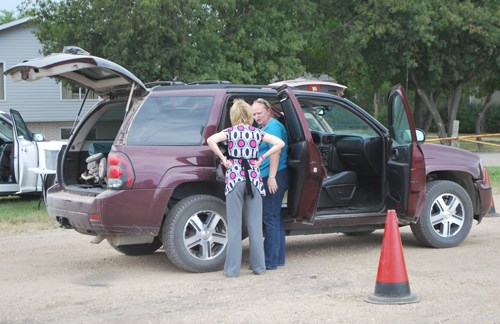Saskatchewan Prevention Institute teamed up with local RCMP Constable Wyatt to offer a Car Seat Safety Clinic in Carlyle on Aug. 29. The clinic, which was held from 11 a.m. to 3 p.m., allowed parents to have the safety of their car seats assessed and learn a wealth of information about transporting children in vehicles.
The clinic, which is sponsored by Saskatchewan Prevention Institute and SGI, is the first clinic in Carlyle for a number of years. Constable Karen Wyatt, the driving force behind offering this, has been a certified technician since May. Prior to that, the closest car seat technicians were located in places such as Oxbow or Yorkton.
Travis Holeha, from Saskatchewan Prevention Institute, stated that any community interested in offering the clinic should contact the institute. If no one in your particular community is certified, the institute will arrange for a technician to be on hand. Not only does SGI provide funding for Holeha's position, they also train summer students for clinics throughout the summer.
The Saskatchewan Prevention Institute states that "proper installation and use of infant and child restraints save the lives of children every year." Their website provides clarity for those parents wondering when their child should move from a rear-facing infant seat, to a forward-facing child seat, and then again, to a booster seat.
The institute states that "the baby's weight, length, age and development are the four factors to consider when using a rear-facing infant seat. Use a rear-facing infant seat until the baby is the weight and length listed on the car seat instructions. In addition to the weight and length specifications, the baby must be kept rear-facing until he or she is one year of age and 10 kg (22 lbs.) and can walk. Do not rush to move your baby forward-facing. A baby under one year of age will have to be moved into a rear-facing convertible car seat if he or she has reached the maximum weight limit of the infant car seat. Most infant seats will safely restrain a baby up to 10 kgs (22 lbs.). For heavier babies who have not yet reached one year of age, use an infant/child convertible car seat allowing a heavier weight in the rear-facing position."
They continue that rear-facing infant seats are used for a number of reasons. "Babies have large heads and weak neck and back muscles. Infant seats face "backwards" so that the force of a crash or sudden stop is spread across the baby's back and supported by the car seat. A baby's neck and back muscles are not strong enough to withstand forces during a crash and thus must be supported by the seat."
As for a forward-facing child seat, they "may be used once the child is one year of age and 10 kg (22 lbs.) and can walk. Forward-facing child seats must be used until the child has reached 18 kg (40 lbs.). When properly installed, a forward-facing child seat protects the child because its three different parts work together. The harness absorbs the forward motion of the child at the moment of impact. Forward-facing seats help to distribute the forces of impact over the strongest parts of the child's body. The vehicle seat belt keeps the child seat in place. The tether strap secures the top of the child seat to the vehicle reducing forward movement of the child's head during a collision. "
"A booster seat can be used "for children weighing between 18 kgs (40 lbs.) and up to 45 kg (100 lbs.), generally until age eight. For this age group, booster seats are the safest way to position a seat belt correctly over a child's body. Children are ready to use a booster seat when they have reached the maximum weight or height of their forward-facing child seat - but no sooner than this. Check the instructions of the booster seat for more information."
For those parents wondering when and for how long their child should use a booster seat, the Institute provides this information. "Booster seats are necessary during the period when children are too big for a forward-facing child seat but are too small for a seat belt. The booster seat works by raising the child in the vehicle seat so the seat belt is properly positioned low over the child's hips. An incorrectly positioned seat belt over a child's abdomen can cause the child to be seriously injured or even killed in a collision."
While reading about the dos and don'ts of car seat safety is helpful, there is nothing better than having a certified technician walk you through the safety of your child seats as they pertain to your growing children. Constable Wyatt provides this service by appointment at the detachment for those in the area. If you would like Constable Wyatt to walk you through this information, contact the detachment at 453-6707.




